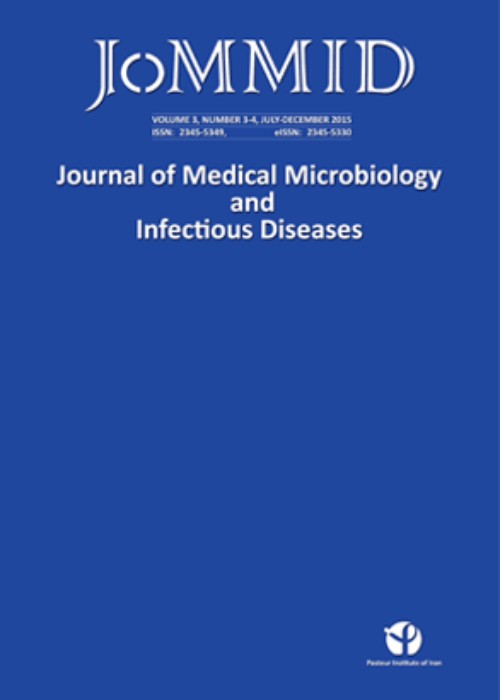Antibiotic Resistance Pattern and Phylogenetic Groups of the Uropathogenic Escherichia coli Isolates Recovered from the Urinary Catheters of the Hospitalized Patients
Author(s):
Abstract:
Introduction
Almost 80% of nosocomial urinary tract infections (UTIs) are due to catheterization. Catheter-associated UTI (CAUTI) is the primary source for colonization of antibiotic-resistant pathogens, and uropathogenic Escherichia coli (UPEC) is the most common causative bacteria. This study was conducted to determine the phylogenetic groups, and antibiotic resistance pattern as the two important features of pathogenicity of UPEC isolates collected from urinary catheters.Methods
The UPEC isolates were obtained from the urinary catheters of the patients without UTI, from two referral hospitals during 2015 to 2016. Phylogenetic grouping was performed using a multiplex PCR. Antibiotic susceptibility and extended spectrum beta-lactamase (ESBL) production were tested by the disc diffusion method. Multidrug resistance was determined based on a recent guideline. The presence of some resistance genes was examined by a PCR assay.Results
Thirty-eight percent of the isolates were UPEC, all of them belonged either to B2 (62.5%) or D (37.5%) phylogenetic groups. The UPEC isolates showed a very high resistance to ciprofloxacin (80%) and the third-generation cephalosporins (72.5%). Seventy percent of the isolates were ESBL-producing, and 90% of them were multiple drug resistant (MDR). Meanwhile, the frequency of the resistance genes: ctxM, aacIV, sul1, shv, and qnrA in the isolates were 95%, 82.5%, 77.5%, 72.5%, and 45%, respectively.Conclusion
High resistance to fluoroquinolones and third-generation cephalosporins, as well as high frequency of ESBL-producing and MDR UPEC isolates, are a great concern. This phenomenon is probably the consequence of the indiscriminate use and on the counter availability of antibiotics, which should be considered in empirical therapy of CAUTIs. Keywords:
Language:
English
Published:
Journal of Medical Microbiology and Infectious Diseases, Volume:4 Issue: 3, Summer-Autumn 2016
Pages:
76 to 82
magiran.com/p1748962
دانلود و مطالعه متن این مقاله با یکی از روشهای زیر امکان پذیر است:
اشتراک شخصی
با عضویت و پرداخت آنلاین حق اشتراک یکساله به مبلغ 1,390,000ريال میتوانید 70 عنوان مطلب دانلود کنید!
اشتراک سازمانی
به کتابخانه دانشگاه یا محل کار خود پیشنهاد کنید تا اشتراک سازمانی این پایگاه را برای دسترسی نامحدود همه کاربران به متن مطالب تهیه نمایند!
توجه!
- حق عضویت دریافتی صرف حمایت از نشریات عضو و نگهداری، تکمیل و توسعه مگیران میشود.
- پرداخت حق اشتراک و دانلود مقالات اجازه بازنشر آن در سایر رسانههای چاپی و دیجیتال را به کاربر نمیدهد.
دسترسی سراسری کاربران دانشگاه پیام نور!
اعضای هیئت علمی و دانشجویان دانشگاه پیام نور در سراسر کشور، در صورت ثبت نام با ایمیل دانشگاهی، تا پایان فروردین ماه 1403 به مقالات سایت دسترسی خواهند داشت!
In order to view content subscription is required
Personal subscription
Subscribe magiran.com for 70 € euros via PayPal and download 70 articles during a year.
Organization subscription
Please contact us to subscribe your university or library for unlimited access!


